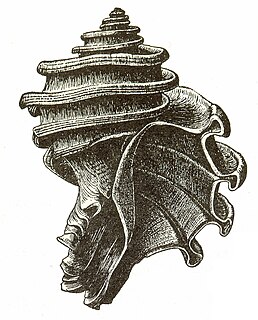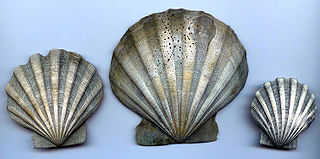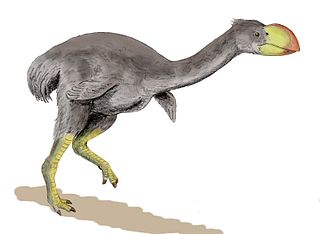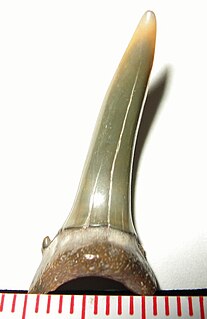Related Research Articles

The bird family Casuariidae has four surviving members: the three species of cassowary and the emu.

Morelia is a genus of large snakes in the family Pythonidae found in Indonesia, New Guinea, and throughout Australia. Currently, up to eight species are recognized.

Ecphora gardnerae is a species of extinct predatory ocenebrinid murex gastropod. Shells of E. gardnerae are found in Miocene-aged marine strata of Maryland and Virginia.

Chesapecten is an extinct genus of scallop known from marine strata from the early Miocene to the early Pleistocene of the Eastern United States.

Dromornis stirtoni, colloquially known as Stirton's thunderbird, a member of the family Dromornithidae, is the second largest flightless bird found through fossil evidence. It was three metres tall and weighed half a tonne. It inhabited subtropical open woodlands in Australia during the Late Miocene and may have been carnivorous. Due to the poor fossil record of Dromornis australis and the large time gap between the two Dromornis species, D. stirtoni may eventually be reassigned to the genus Bullockornis.

The redtail catfish, Phractocephalus hemioliopterus, is a pimelodid (long-whiskered) catfish. In Venezuela, it is known as cajaro, and in Brazil, it is known as pirarara, stemming from the Tupi language words pirá and arara. It is the only extant species of the genus Phractocephalus. This fish is common in the aquarium trade, although its massive adult size makes it unsuitable for all but the largest aquariums.

Thylacoleonidae is a family of extinct meat-eating marsupials from Australia, referred to as marsupial lions. The best known is Thylacoleo carnifex, also called the marsupial lion. The clade ranged from the Late Oligocene to the Pleistocene, with some species the size of a possum and others as large as a leopard. As a whole, they were largely arboreal, in contrast to the mostly terrestrial dasyuromorphs, monitor lizards and mekosuchines.

Desmostylus is an extinct genus of herbivorous mammal of the family Desmostylidae living from the Chattian stage of the Late Oligocene subepoch through the Late Miocene subepoch and in existence for approximately 21.2 million years .
Wakaleo was a genus of medium-sized thylacoleonids that lived in Australia in the Late Oligocene and Miocene Epochs. Although much smaller than its close relative, the marsupial lion, Wakaleo would have been a successful hunter. It had teeth specially designed for cutting and stabbing. The genus is from an extinct family of Vombatiformes, so it is distantly related to the herbivorous wombats.
Wynyardiidae is an extinct family of possum-like marsupials from the early Miocene of Wynyard in Tasmania, long been considered to display skeletal features that are intermediate between the primitive polyprotodont and the advanced diprotodont marsupials.
The Cypress Hills Formation is a stratigraphic unit of middle Eocene to early Miocene age in the Western Canada Sedimentary Basin. It is named for the Cypress Hills of southeastern Alberta and southwestern Saskatchewan and was first described from outcrops on the slopes of the Cypress Hills in 1930. It is known for preserving a wealth of vertebrate fossils.

Anna Katherine "Kay" Behrensmeyer is an American taphonomist and paleoecologist. She is a pioneer in the study of the fossil records of terrestrial ecosystems and engages in geological and paleontological field research into the ecological context of human evolution in East Africa. She is Curator of Vertebrate Paleontology in the Department of Paleobiology at the Smithsonian Institution's National Museum of Natural History (NMNH). At the museum, she is co-director of the Evolution of Terrestrial Ecosystems program and an associate of the Human Origins Program.

The Bone Valley Formation is a geologic formation in Florida. It is sometimes classified as the upper member of the Peace River Formation of the Hawthorn Group. It contains economically important phosphorite deposits that are mined in west-central Florida, as well as rich assemblages of vertebrate fossils.
The Delaho Formation is a geologic formation dating from the Pliocene and Miocene in Texas. It preserves fossils.

The Popotosa Formation is a geologic formation in New Mexico. It preserves fossils dating back to the Neogene period.
The Topanga Canyon Formation is a Miocene epoch geologic formation in the Santa Monica Mountains, Simi Hills, Santa Ana Mountains and San Joaquin Hills, in Los Angeles County, Ventura County, and Orange County, southern California. It is primarily composed of hard sandstone with some inter-bedded siltstone.

The Santa Margarita Formation is a Neogene Period geologic formation in the San Joaquin Valley of central California.
Anomphalus jaggerius is an extinct species of Permian sea snail. Fossils have been found in Artinskian era limestone from the Bird Spring Formation in the southern Arrow Canyon Range of the US State of Nevada. The species, which had a shell 6.37 millimetres (0.251 in) wide, was a subtidal epifaunal grazer. It was named after Rolling Stones lead singer Mick Jagger.

"Oi!" is the debut single by English grime group More Fire Crew, taken from their debut studio album More Fire Crew C.V. It was first released as a promotional single in 2001, and later released commercially on 4 March 2002.
Suzanne J. Hand is an associate professor at the University of New South Wales, a teacher of geology and biology, who has a special interest in vertebrate palaeontology and modern mammals. Her research has been published in over a hundred articles, and is especially focused on the subjects of evolutionary biology, functional morphology, phylogenetics, and biogeography. Hand is a co-leader of the research team investigating the Riversleigh World Heritage Area, regarded as one of the four most important sites of fossil-bearing formations in the world.
References
- ↑ MATSUOKA, HIROSHIGE; SAKAKURA, FUJIO; OHE, FUJIO (December 30, 1998). "A Miocene Pseudodontorn". Paleontological Research. 2 (4): 246. Retrieved 23 December 2014.CS1 maint: discouraged parameter (link)
- ↑ Feral, Jean-Pierre; Bruno, David (2001). Echinoderm Research 2001. CRC Press. p. 56. ISBN 9789058095282.
- ↑ "Ophiomusium lymani". Encyclopedia of Life. National Museum of Natural History (USA). Retrieved 23 December 2014.CS1 maint: discouraged parameter (link)